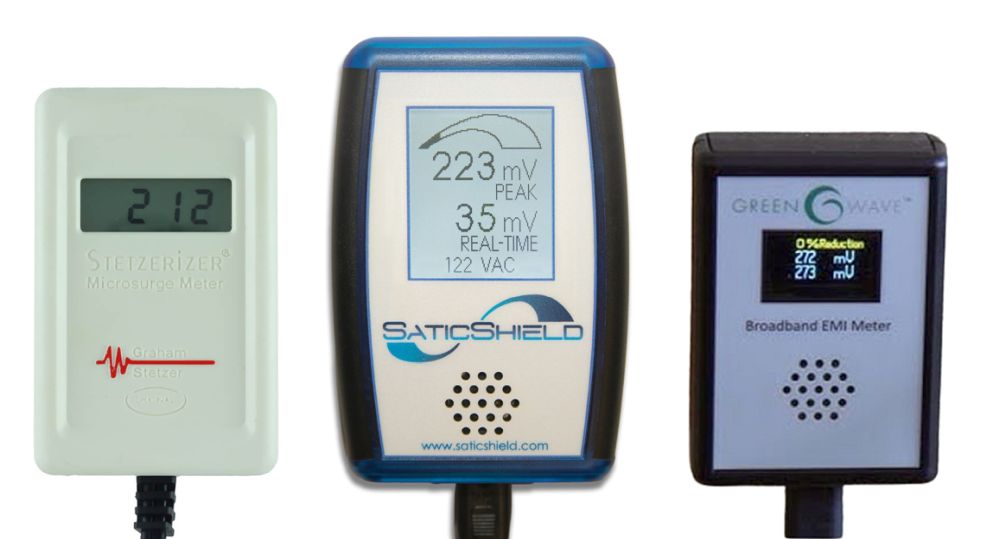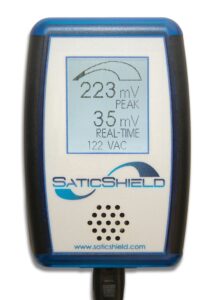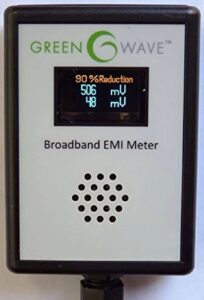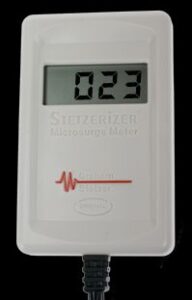
You can get an idea of your dirty electricity levels by using a dirty electricity meter. I will discuss three different dirty electricity meters here: the one made by Satic, which I sell, the one sold by Greenwave (which is made by AlphaLab), and the Stetzer meter. The companies tend to call these “line EMI meters,” “line EMI monitors,” “broadband EMI meters,” or “microsurge meters,” but everyone else calls them “dirty electricity meters.” I also rent a dirty electricity meter for just $21 for a week. Contact me for details.
The SaticShield and the Greenwave meters measure dirty electricity in millivolts. The Stetzer microsurge meter measures using a proprietary algorithm. In addition to manufacturing its own branded meter, AlphaLab makes the meters sold under the Greenwave, Trifield, and many other brands. Bear in mind that while meters manufactured by AlphaLab all look similar, internally they are not and some do a better job of measuring than others.
The SaticShield meter measures the widest range of frequencies (see chart below).
With the exception of the AlphaLab meter (see end of article), you want levels that are below 50; ideally they will be below 25.
If you want to be more precise and you want to measure a wider range of frequencies, then you should use the Satic meter. All the meters are easy to use. You just plug them into outlets and see what the readings are. The Satic will measure a much, much wider frequency range, so if you don’t already have a dirty electricity meter, I suggest buying the SaticShield Line EMI Monitor from me.
You can see some of the differences in the three meters in the chart below.
| Satic Meter | Greenwave Meter | Stetzer Meter | |
| Measurement units | Millivolts (mV) | Millivolts (mV) | Graham-Stetzer units (GS) |
| Measurement range | 5 kHz to 25,000 kHz | 10 to 10,000 kHz (can measure as low as 3 kHz, but numbers become somewhat unstable) | 10 kHz to 150 kHz |
| Units of measurement | Much finer | Much finer | Less fine |
| Shows before and after readings | Yes | Yes | No, but you can easily calculate |
| Shows voltage coming in on the line (VAC) | Yes | No | No |
| Read-out | LCD, large font | LED, very small font | LCD, large font |
| Sound Indicator (buzzing sound increases as more DE is found; will also pick up any AM radio on the wiring) | Yes (cannot be turned off) | Yes (can be turned off) | No |



The SaticShield and Greenwave meters measure dirty electricity in the standard electrical measurement unit of millivolts. Because the Satic and Greenwave meters measure a much wider range of dirty electricity frequencies than the Stetzer meter, you will see constant fluctuations in the readings. With the Stetzer, things will hold steadier.
I have compared the Stetzer and Greenwave meters side-by-side. In general, the readings correlate. However, in some cases, the Greenwave meter picked up problems that the Stetzer meter did not. This is because it measures a much greater range of frequencies (more than 100 times the range of the Stetzer).
The Satic meter is newer on the market and measures a wider range of frequencies than any of the other meters. Readings on the Satic Line EMI meter after installing Power Perfect filters usually, but do not always, correlate with Greenwave meter readings: Sometimes they are lower, sometimes they are higher, and sometimes they are about the same. The Satic Line EMI meter is giving you the results of a much broader range of frequencies:
- Satic meter: 5 kHz to 25,000 kHz
- Greenwave meter: 10 to 10,000 kHz
and is therefore giving you information the Greenwave cannot.
The Stetzer meter was designed by Dave Stetzer with a proprietary algorithm in order to sell his plug-in filters. Since the algorithm is proprietary, no one knows exactly how things are being measured.
The Satic meter can measure up to 25 MHz. The Greenwave meter can measure up to 10 MHz. The Stetzer meter can measure only up to 0.1 MHz. Therefore, the Satic meter measures a wider range of frequencies. The Satic dirty electricity filters filter out dirty electricity from 1 kHz to 100 MHz.
Keep in mind that if you have Stetzer or Greenwave filters in your home, they are filtering out a much smaller range of frequencies than the Satic Power Perfect does. This will not be reflected in the read-out because it does not measure up to 100 MHz. So, numbers can look good with Stetzer or Greenwave filters, but the filters can’t capture the higher frequencies that the Power Perfect does. There are many other problems inherent to Stetzer and Greenwave filters, including the fact that they put a magnetic field on the wiring and filter only the hot wire.
The SaticShield and Stetzer meters have an LCD readout with large, easy-to-read numbers. LCD readouts are much easier on the eyes (and way less harmful) than LED readouts. The Satic meter is largest in size, therefore easy to read. It measures 4.7 inches long by 3.1 inches wide (12 cm x 7.9 cm). The Satic meter measures dirty electricity in millivolts, which is a standard unit of electrical measurement. The Stetzer uses “Stetzer units.” The Stetzer meter is 4.25 inches long by 2.75 inches wide.
The Greenwave meter has a green LED read-out. Like the Satic line EMI meter, it measures dirty electricity in millivolts. The read-out numbers are quite small in size. It is the smallest meter, coming in at 3.5 inches long by 2.5 inches wide.
The Greenwave and Satic meters can be used with a sound indicator as well. A speaker plays the sound of the EMI, amplitude demodulated, in order to identify the EMI source (such as an AM or shortwave radio station vs a motor vs an electric arc). The sound function can be turned off on the Greenwave meter but is always on on the Satic.
Having a sound function is good, because not only does it give you an audio indication of dirty electricity levels, it will also pick up any AM radio that has jumped on to your wiring. I once trailed a building biologist who was doing an assessment. I had left the room, and as I came back I heard what was obviously an interview playing. I thought she must have pulled up a youtube video on her hardwired computer. I was astonished when it turned out to be a radio station clearly playing through the homeowner’s wiring into the dirty electricity meter that was plugged into an outlet in the kitchen.
Please be aware that many people will tell you that dirty electricity levels of 60 or below are of no concern, and that even levels up to 100 are not particularly harmful. This is simply untrue. I lived for at least 5 ½ years in a house with dirty electricity levels that were generally around 60 (but would range up to 120). After installing the Power Perfect filter, I felt so much better! Sixty is not a safe level and does affect your health. In fact, you want to have readings at least below 50, but ideally below 25. The Building Biology Institute is revising its guidelines for safe dirty electricity levels, which are currently set at 100. EMF-sensitive people such as myself know that this is much too high.
The SaticShield whole-house and plug-in filters will reduce your dirty electricity levels by about 90 percent.
Important note: The AlphaLab-branded meter is calibrated entirely differently than all the other meters. It will read five times LOWER than the other meters per measurements done by someone who has tested all sorts of line EMI meters. So if you own an AlphaLab meter, you want levels below 10. In my opinion, the AlphaLab meter is therefore useless.
To order Satic products directly at the lowest price, contact:
Linda Kurtz, LindaKurtz@NoDirtyElectricity.com
Call 520-398-2985 (landline) or 734-972-2677 (messages only).
Email: SmartMeterEducationNetwork@gmail.com (best email) or LindaKurtz@NoDirtyElectricity.com (replies will come from SmartMeterEducationNetwork@gmail.com)